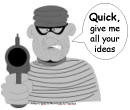 The Thief
The Thief 
Le Voleur is French for the Thief. In 1828, during the birth and rise of the newspaper, Emile de Girardin had a novel idea on how to use the newest writing technology, the printing press. He and a friend decided to start a periodical, but since they lacked capital, the weekly was entitled Le Voleur (The Thief) and it reprinted the best articles that had appeared elsewhere during the week, saving editorial costs. (from ''The History and Power of Writing'')
Sunday, April 30, 2006
New York Times: "College is still probably a good idea, but everything you need to know about America you can learn in high school. For example, if you want to understand American class structure you'd be misled if you read Marx, but you'd understand it perfectly if you look around a high school cafeteria.
The jocks sit here; the nerds sit there; the techies, drama types, skaters, kickers and gangstas sit there, there and there. What you see is not class in the 19th-century sense, but a wide array of lifestyle cliques, some richer, some poorer, but each regarding the others as vaguely pathetic and convinced of its moral superiority. Similarly, when it comes to politics, high school explains most everything you need to know. In 1976, Tom Wolfe wrote an essay for Commentary in which he noted that our political affiliations are shaped subrationally. He went on to observe that especially when we are young and forming our identities, we make sense of our lives by running little morality plays in our heads in which the main characters are Myself, the hero, and My Adolescent Opposite, the enemy. 'Forever after,' Wolfe writes, 'the most momentous national and international events are stuffed into the same turf. The most colossal antagonists and movements become merely stand-ins for My Adolescent Self and My Adolescent Opposite. 'If My Opposite, my natural enemy in adolescence, was the sort of person who seemed overly aggressive, brutish and in love with power, I identify him with the 'conservative' position. If My Opposite, my natural enemy in adolescence, seemed overly sensitive, soft, cerebral and incapable of action, I identify him with the 'liberal' position.'"
The jocks sit here; the nerds sit there; the techies, drama types, skaters, kickers and gangstas sit there, there and there. What you see is not class in the 19th-century sense, but a wide array of lifestyle cliques, some richer, some poorer, but each regarding the others as vaguely pathetic and convinced of its moral superiority. Similarly, when it comes to politics, high school explains most everything you need to know. In 1976, Tom Wolfe wrote an essay for Commentary in which he noted that our political affiliations are shaped subrationally. He went on to observe that especially when we are young and forming our identities, we make sense of our lives by running little morality plays in our heads in which the main characters are Myself, the hero, and My Adolescent Opposite, the enemy. 'Forever after,' Wolfe writes, 'the most momentous national and international events are stuffed into the same turf. The most colossal antagonists and movements become merely stand-ins for My Adolescent Self and My Adolescent Opposite. 'If My Opposite, my natural enemy in adolescence, was the sort of person who seemed overly aggressive, brutish and in love with power, I identify him with the 'conservative' position. If My Opposite, my natural enemy in adolescence, seemed overly sensitive, soft, cerebral and incapable of action, I identify him with the 'liberal' position.'"
0 Comments:
GoogleNews Map
NY Times
Cost of the War in Iraq
(JavaScript Error)

| CURRENT MOON lunar phases |
Play Chess
RSS
Fighting the Good Fight
- Democracy Now!
- Crooks and Liars
- Common Dreams
- Money in Politics
- The Drudge Report
- Corporation Watch
- Noam Chomsky
- Info Wars
- Free Press
- Bill of Rights
- US Constitution
- Z Magazine
- Save the Internet
- Military Industrial Complex
- Stop Illegal Spying









2005-02-13
2005-02-20
2005-02-27
2005-03-06
2005-03-13
2005-03-20
2005-03-27
2005-04-03
2005-04-10
2005-04-17
2005-04-24
2005-05-01
2005-05-15
2005-05-29
2005-06-05
2005-06-19
2005-06-26
2005-07-03
2005-07-10
2005-07-17
2005-07-24
2005-07-31
2005-08-07
2005-08-14
2005-08-21
2005-08-28
2005-09-04
2005-09-11
2005-09-18
2005-09-25
2005-10-02
2005-10-09
2005-10-16
2005-10-23
2005-10-30
2005-11-06
2005-11-13
2005-11-20
2005-11-27
2005-12-04
2005-12-11
2005-12-18
2006-01-01
2006-01-22
2006-02-05
2006-02-19
2006-02-26
2006-03-05
2006-03-12
2006-03-19
2006-03-26
2006-04-09
2006-04-30
2006-05-14
2006-05-21
2006-06-18
2006-06-25
2006-07-02
2006-07-09
2006-07-23
2006-08-06
2006-12-17